
-Proportionality/linearity-variables forming the basis of the problem vary in direct proportion with the
level of activity.
-Certainty/deterministic-coefficients in the objective and constraints are known with
certainty Divisibility- fractional levels for variables in objective and constraints are allowed.
-Additive- the total contribution of all activities are identical to the sum of the contribution of each
activity taken individually
-Time factor is ignored
OR
1. Linearity: It describes the relationship among two or more variables which are directly proportional.
2. Additivity: Total input required is the sum of the resources used by each activity. Total product is sum of the production from each activity.
3. Divisibility: Resources can be used in fractional amounts. Similarly, the output can be produced in fractions.
4. Finiteness of activities and resource restrictions: There is limit to the number of activities and resource constraints.
5. Non negativity: Resources and activities cannot take negative values. That means
the level of activities or resources cannot be less than zero.
6. Single value expectations: Resource supplies, input-output coefficients and prices
are known with certainty.
Wilfykil answered the question on February 20, 2019 at 08:48
-
The following data relates business turnover and staff of fast moving consumer goods company EAI Ltd:
(Solved)
The following data relates business turnover and staff of fast moving consumer goods company EAI Ltd:

Required:
i) Fit an appropriate regression equation.
ii) Estimate the staff requirement when business turnover reaches Sh.200 Million
Date posted:
February 20, 2019
.
Answers (1)
-
A survey by Marketing Society here in Kenya found out the following buying habits of household air conditioners considered a luxury.
(Solved)
A survey by Marketing Society here in Kenya found out the following buying habits of household air conditioners considered a luxury.
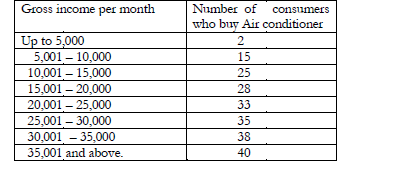
Required:
i)Calculate the arithmetic mean, median and mode. (5 marks)
ii) Does the survey show that the luxury item is consumed by high-income earners? Show your answer by calculating appropriate measure of skewness
Date posted:
February 20, 2019
.
Answers (1)
-
Lillian Wambugu is the project manager of Jokete Construction Company. The company is bidding a contract to install telephone lines in a small town. It...
(Solved)
Lillian Wambugu is the project manager of Jokete Construction Company. The company is bidding a contract to install telephone lines in a small town. It has identified the following activities along with their predecessor restrictions, expected times and worker requirements:
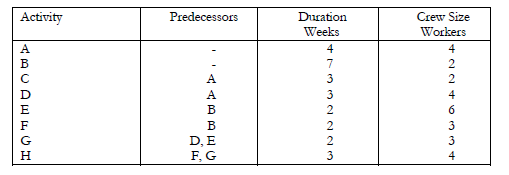
Lillian Wambugu has agreed with the client that the project should be completed in the shortest duration.
Required:
i) Draw a network for the project.
ii) Determine the critical path and the shortest project duration.
iii) Lillian Wambugu will assign a fixed number of workers to the project for its entire duration and so she would like to ensure that the minimum number of workers is assigned and that the project will be completed in 14 weeks. Draw a schedule showing how the project will be completed in 14 weeks
iv) Comment on the schedule you have drawn in (iii) above.
Date posted:
February 20, 2019
.
Answers (1)
-
A small construction project involves the following activities:
Required:
i) Determine the shortest time and associated cost to finish this project.
ii) If a penalty of Sh.4,500 must...
(Solved)
A small construction project involves the following activities:

Required:
i) Determine the shortest time and associated cost to finish this project.
ii) If a penalty of Sh.4,500 must be charged for every day beyond 12 days, what is the most economical time for completing the project?
Date posted:
February 20, 2019
.
Answers (1)
-
Consider the following project network and activity times (in weeks)
Required:
i) How long will it take to finish this project?
ii) Can activity D be delayed without...
(Solved)
Consider the following project network and activity times (in weeks)
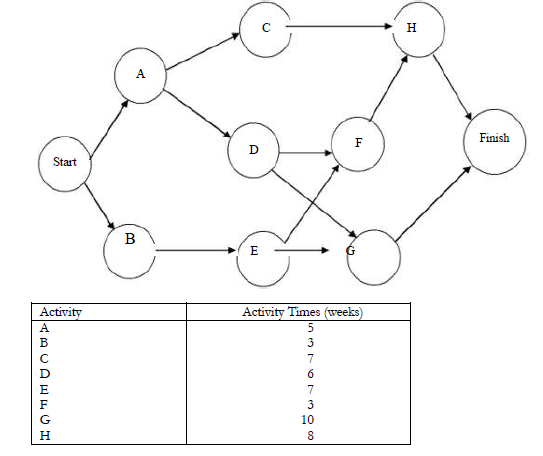
Required:
i) How long will it take to finish this project?
ii)Can activity D be delayed without delaying the entire project? If so, by how many weeks?
iii)What is the schedule for activity E?
Date posted:
February 20, 2019
.
Answers (1)
-
Explain the following terms used in network analysis:
i) Network planning;
ii) Activities;
iii) Events;
iv) Critical path;
v) Float.
(Solved)
Explain the following terms used in network analysis:
i) Network planning;
ii) Activities;
iii) Events;
iv) Critical path;
v) Float.
Date posted:
February 20, 2019
.
Answers (1)
-
Consider a project which has been modeled as follows:
Required:
a) Determine the project?s expected completion time and its critical path.
b) Can activities E and G be...
(Solved)
Consider a project which has been modeled as follows:
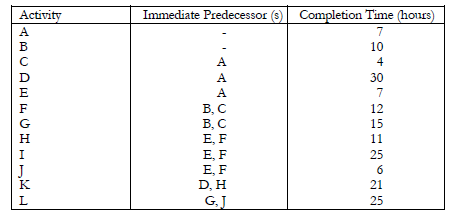
Required:
a) Determine the project‟s expected completion time and its critical path.
b) Can activities E and G be performed at the same time without delaying the completion of the project?
c) Can one person perform activities A, G and I without delaying the project?
d) By how much time can activities G and L be delayed without delaying the entire project?
e) By how much time would the project be delayed if activity G were delayed by 3 hours and activity L by 4 hours? Explain.
Date posted:
February 20, 2019
.
Answers (1)
-
Consider the cost-time estimates for the product development project as given in the table below.
(Solved)
Consider the cost-time estimates for the product development project as given in the table below.

Indirect cost is made up of two components: Fixed cost of $5,000 and a variable cost of $1,000 per week of elapsed time. Also, for each week the project exceeds 17 weeks, an opportunity cost of $2,000 per week is assessed.
Construct a time chart for the minimum total cost schedule.
Date posted:
February 20, 2019
.
Answers (1)
-
Consider the simplified scenario for the development of a consumer product through the market test phase
shown in the table below.
(Solved)
Consider the simplified scenario for the development of a consumer product through the market test phase
shown in the table below.

a) Draw the network for this project.
b) Calculate the slacks and interpret their meaning.
c) Determine the critical path and interpret its meaning.
d) Construct a time chart and identify scheduling flexibilities
Date posted:
February 20, 2019
.
Answers (1)
-
Consider the two person zero sum game between players A and B given by the following pay-off table:
(Solved)
Consider the two person zero sum game between players A and B given by the following pay-off table:

Required:
i) Using the maximin and minimax values, is it possible to determine the value of the game? Give
reasons.
ii) Use graphical methods to determine optimal mixed strategy for player A and determine the
value of the game.
Date posted:
January 23, 2019
.
Answers (1)
-
Define the following terms used in game theory:
i) Dominance.
ii) Saddle point
iii) Mixed strategy
iv) Value of the game
(Solved)
Define the following terms used in game theory:
i) Dominance.
ii) Saddle point
iii) Mixed strategy
iv) Value of the game
Date posted:
January 23, 2019
.
Answers (1)
-
Explain the following terms as used in decision analysis.
a) Decision making under risk versus uncertainty.
b) Decision trees versus probability trees.
c) Minimax versus maximax criterion.
d) Pure...
(Solved)
Explain the following terms as used in decision analysis.
a) Decision making under risk versus uncertainty.
b) Decision trees versus probability trees.
c) Minimax versus maximax criterion.
d) Pure strategy versus mixed strategy games.
e) Games with more than two persons versus non zero-sum games
Date posted:
January 23, 2019
.
Answers (1)
-
An urban cable television company is investigating the installation of cable TV system in urban areas. The engineering department estimates the cost of the system...
(Solved)
An urban cable television company is investigating the installation of cable TV system in urban areas. The engineering department estimates the cost of the system (in present worth Sh.) to be Sh. 7 million. The sales department has investigated four pricing plans. For each pricing plan, the marketing division has estimated the revenue per household in present worth Sh. to be:
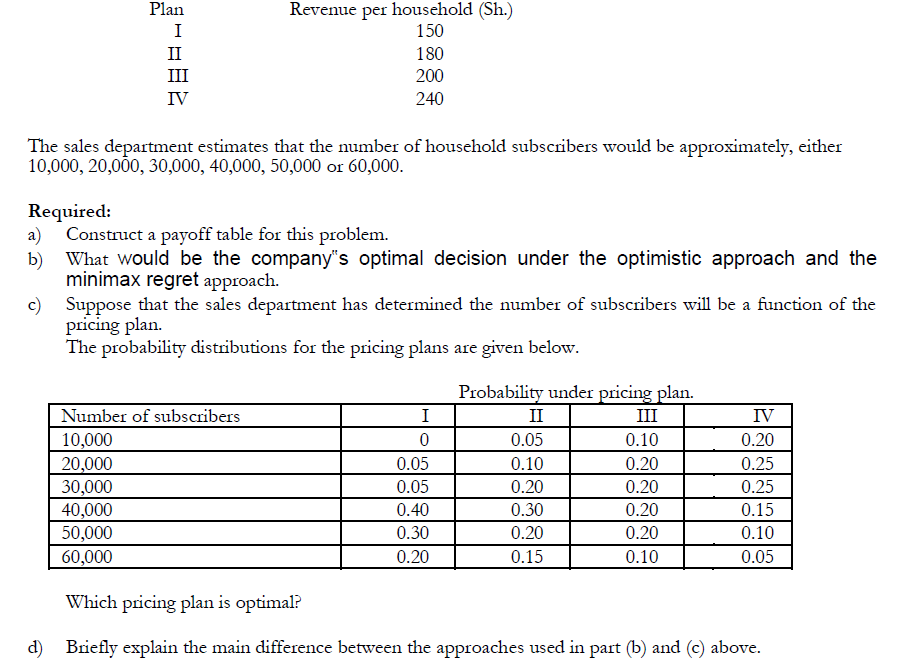
Date posted:
January 23, 2019
.
Answers (1)
-
A trust officer for a major banking institution is planning the investment of a USD 1 million family trust for the coming year. The trust...
(Solved)
A trust officer for a major banking institution is planning the investment of a USD 1 million family trust for the
coming year. The trust officer has identified a portfolio of stocks and another group of bonds that might be
selected for investment. The family trust can be invested in stocks or bonds exclusively, or a mix of the two.
This trust officer prefers to divide the funds in increments of 10 percent; that is, the family trust may be split
100 percent stocks /0 percent bonds, 90 percent stocks /10 percent bonds, 80 percent stocks /20 percent
bonds, and so on.
The trust officer has evaluated the relationship between the yields on the different investments and general
economic conditions. Her judgment is as follows:
1) If the next year is characterized by solid growth in the economy, bonds will yield 12 percent and stocks
20 percent.
2) If the next year is characterized by inflation, bonds will yield 18 percent and stocks 10 percent.
3) If the next year is characterized by stagnation, bonds will yield 12 percent and stocks 8 percent.
a) Formulate a payoff table where payoffs represent the annual yield, in dollars, associated with the
different investment strategies and the occurrence of various economic conditions
b) Determine the optimal investment strategy using the max-max, max-min, Hurwicz ( ),
),
equally likely, and regret criteria.
c) Suppose that a leading economic forecasting firm projects P(solid growth)= 0.4, P(inflation)=0.25,
and P (stagnation)= 0.35. Use the expected value criterion to select the appropriate strategy.
d) What is the expected value with perfect information?
Date posted:
January 23, 2019
.
Answers (1)
-
The following table is a payoff table for a particular venture.
(Solved)
The following table is a payoff table for a particular venture.

Required:
a) Determine the decision alternative that maximizes expected payoff.
b) Determine expected value under certainty.
c) What is the expected value of perfect information?
Date posted:
January 23, 2019
.
Answers (1)
-
The following is a payoff table for a particular venture.
(Solved)
The following is a payoff table for a particular venture.

Determine the optimal decision using:
a) Max-min criterion.
b) Max-max criterion.
c) Min-max regret criterion.
d) Maximum expected payoff (assuming equal likelihood of states of nature).
Date posted:
January 23, 2019
.
Answers (1)
-
Kenya Canning Transport is to move goods from three factories situated in Thika, Naivasha and
Machakos. These goods will be distributed to Nairobi, Mombasa and Kisumu....
(Solved)
Kenya Canning Transport is to move goods from three factories situated in Thika, Naivasha and
Machakos. These goods will be distributed to Nairobi, Mombasa and Kisumu. Information about the
units (in kilograms) to be moved is given below:
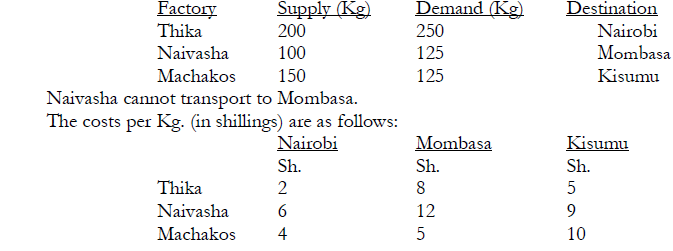
Required:
i) Draw a network diagram for the above problem
ii) Set a linear programming model for this problem
NOTE: Do not solve.
Date posted:
January 14, 2019
.
Answers (1)
-
The TamuTamu products company ltd is considering an expansion into five new sales districts. The
company has been able to hire four new experienced salespersons. Upon...
(Solved)
The TamuTamu products company ltd is considering an expansion into five new sales districts. The
company has been able to hire four new experienced salespersons. Upon analysing the new
salesperson's past experience in combination with a personality test which was given to them, the
company assigned a rating to each of the salespersons for each of the districts .These ratings are as follows:

The company knows that with four salespersons, only four of the five potential districts can be covered.
Required:
i) The four districts that the salespersons should be assigned to in order to maximize the total of the
ratings
ii) Maximum total rating.
Date posted:
January 14, 2019
.
Answers (1)
-
a) A baker makes two products; large loaves and small round loaves. He can sell up to 280 of the large
loaves and up to 400...
(Solved)
a) A baker makes two products; large loaves and small round loaves. He can sell up to 280 of the large
loaves and up to 400 small round loaves per day. Each large loaf occupies 0.01m3 of shelf space, each small loaf occupies 0.008m3 of space, and there is 4m3 of shelf space available. There are 8 hours available each night for baking, and he can produce large loaves at the rate of 40 per hour, and small loaves at the rate of 80 per hour. The profit on each large loaf is Sh.5.00 and Sh.3.00 profit on the small round loaf.
Required:
In order to maximize profits, how many large and small round loaves should he produce?
b) Summarize the procedure for solving the kind of quantitative technique you have used to solve part (a) above.
Date posted:
January 11, 2019
.
Answers (1)
-
A company wishes to purchase additional machinery in a capital expansion program. Three types of machinesare to be purchased: A, B, and C. Machine A...
(Solved)
A company wishes to purchase additional machinery in a capital expansion program. Three types of machines
are to be purchased: A, B, and C. Machine A costs USD 25,000 and requires 200 square feet of floor space for its
operation. Machine B costs USD 30,000 and requires 250 square feet of floor space. Machine C costs USD 22,000 and
requires 175 square feet of floor space. The total budget for this expansion program is USD 350,000. The
maximum available floor space for the new machines is 4,000 square feet. The company also wishes to
purchase at least one of each machine.
Given that machines A, B, and C can produce 250, 260, and 225 pieces per day, the company wants to
determine how many machines of each type it should purchase so as to maximize daily output (in units) from
the new machines.
a) Explicitly define your decision variables and formulate the LP model.
b) Assess the validity of the four underlying LP assumptions for this problem.
c) Solve and analyse the problem using a computer package
Date posted:
January 11, 2019
.
Answers (1)